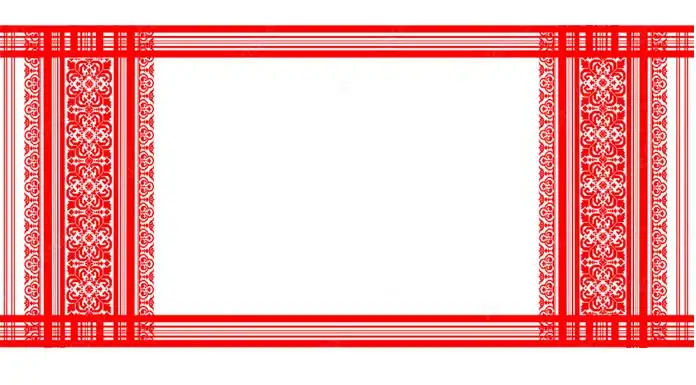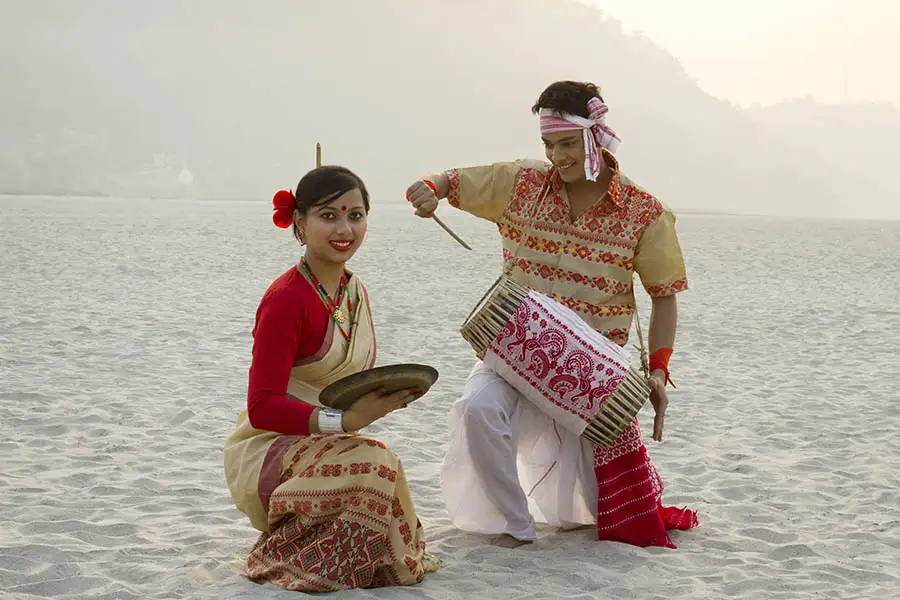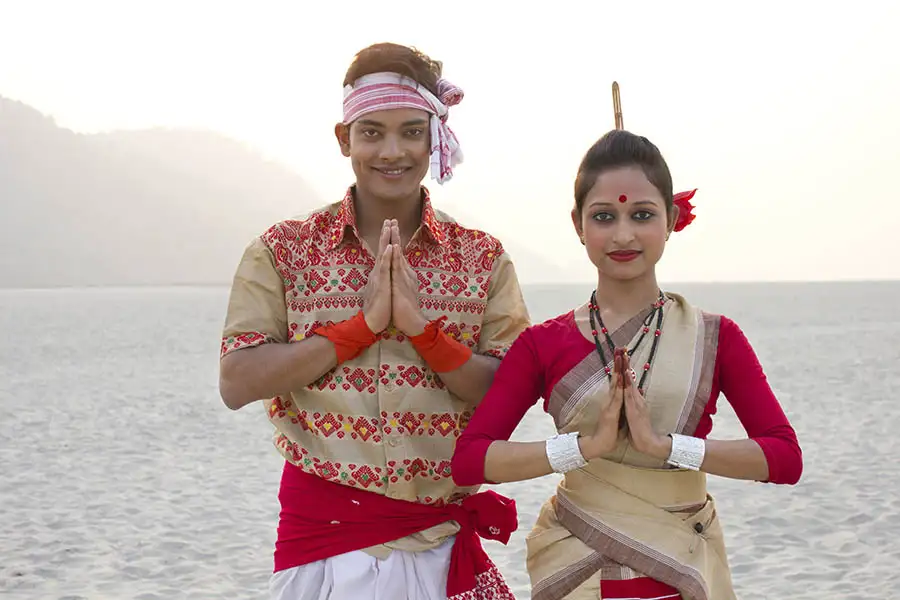Traditional dress of Assam for male and Female | Traditional dress for Bodo, Rabha, Garo, Hajong, Karbi and Mising Tribe.
Assam is the hub of meeting grounds of diverse culture. It has both races- tribal and non-tribal population. Traditional Dress of Assam has is rich, unique and exotic mixture of all the races of Assam. In order to keep our culture alive and vibrant, we must know, share, and discuss about the traditional dress of Assam and its people.
The primary traditional dress of Assam is Mekhela Chador made from Assam Silk. But there are many traditional dresses worn by people of Assam like Churia, Cheleng, Dokhona, Kotip, etc. Gamucha is the cultural symbol of Assam and an integral part of all social and religious ceremonies.
Let us go in greater detail to discuss each and every traditional dress of Assam.
What are traditional Dresses?
Everyone on this planet has a rich culture from where we belong. Each culture has unique dress, jewellery and accessories associated with the past. This unique culture is carried on from generation to generation and still a large group of people follow this culture.
So, traditional dresses are the dresses worn by an identifiable group of people that are deeply associated with your culture.
Traditional dresses have evolved in due course of time to adapt to the changing circumstances.
Importance of Traditional Dress
Wearing traditional dress is as good as wearing modern or western dress. Your wardrobe is incomplete without traditional dress or ethnic wear. Every person be it man or woman has at least one pair of traditional dress.
Let us list the importance of traditional dress.
- Wearing traditional Dress is the true manifestation of our rich culture and tradition
- It shows how we value and respect our tradition.
- Traditional Dress gives you distinct cultural and traditional appeal.
- It makes you look fashionable, gorgeous and a fashionista.
- Women look more beautiful in traditional clothes.
History of Traditional Dress of Assam
Ancient texts like Kalika Purana and Harsha Charitra have proper evidence regarding the dress worn by the people of Assam in Ancient times. During the Ahom rule, the traditional dress of Assam witnessed drastic change.
Dress of Assam in Ancient times
Prior to Ahom rule, the men of Assam wore Churia or Dhuti. It was an unstitched lion cloth tied around the waist. Common people wore churia above the knee. The middle men wore it till their ankles. The upper part of the body was covered with chador.
Women wore two garments-upper and lower.. The lower garments descended from the stomach to ankles. .They wore Riha- Mekhela and celeng. Riha was an ornamental scarf wrapped around the waist. Over the riha, shawal was worn known as celeng.
Dress of Assam during Ahom rule
During the Ahom rule, the traditional dress of Assam witnessed drastic change.The Ahom introduced Sola (shirt), Chapkan, etc. From this time the men started wearing turban called Paguri or Pag. It was mainly worn by high officials during Ahom rule.
Traditional Dress of Assam
Assam is the hub of meeting grounds of diverse culture.It has both races- tribal and non-tribal population. It is an intermixture of different races- Mongoloid, Indo-Burmese, Indo-Iranian and Aryan.
Diverse tribes like Bodo, Kacharis, Miri, Rabha, Garo live in harmony with each other. They have their own language and culture. They have different traditional dresses they wear. But the primary traditional dress of Assam is Chola and Churai(Dhoti) for men and Mekhla-Chadar for women.
Let us discuss the important traditional dress of Assam in detail.
Gamosa

Gamosa is the culturable symbol of Assam. It is a symbol of respect and an honorary piece of cloth. Gamosa is a rectangular piece of cotton in the shape of a bathing towel. It is handwoven in handloom. It is white in color with a red border on three sides and red woven motifs on the fourth side.
Use of Gamosa
- It is commonly used to facilitate people,elder one and accomplished members of society.
- Gamosa is qiven as a gift during festivals as Bihuwaan. It shows expressions of love and friendship.
- It is used as a towel to wipe our face and body.
- Gamosa is used as a waist cloth or a loincloth
- Gamosa is used in Bihu. A Bihu dancer wraps it around his head.
- It is hung around the neck as a scarf. It signifies social status or respect.
- Gamosa is also used for decorating altars and covering religious books.
Mekhela Chador

Mekhela Chador is the primary traditional dress of Assam worn by women. Assam is famous worldwide for its muga silk mekhela chador. It is used in daily lifestyle as well as in special occasions.
Mekhela Chador comprises two pieces of cloth, draped on the top and bottom. Mekhla is worn from the waist to toes and form the bottom half. It is cylindrical in shape and worn waist downwards over a petticoat.
The chador on the other hand, is tucked into the mekhela at one end. The other end is used for drapping around the upper portion of the body.
The wearing of Mekelea chador is an intricate process. The Mekhela is worn around the waist and by making 3 folds. Nowadays women wear stitched blouses. But earlier riha was used in its place.
Riha
Riha is usually worn by Assamese brides like dupatta in modern times. It is an unstitched corset made of Assam Silk. It is a long narrow strip of silk of 3 meters long. Muga Silk riha are expensive but nowadays eri and cotton riha are used.
Traditionally, riha is a private item of clothing. It is worn under the chador. It was usually worn to support the breast. This is still prevalent in rural areas.
The transition of riha from private clothing to bridal dupatta is a fascinating cultural mixture.
Ghagra/Ghuri
Ghuri or Ghagra is similar to the ghagra worn by females in marriage ceremonies. But as a traditional cloth, it is the dress primarily worn by sattriya female dancers. Sometimes it is also worn by Bihu dancers
It is a cloth worn from the waist made of pat silk. Ghuri dress has floral design at the lower portion. Alongwith guri, the sattriya dancer wears kanchi as waist gear.
Eri Shawl
Shawl made of eri silk is commonly used by women in the winter season. It is worn both by men and women. Eri shawal is known for its durability and increase of warmth after each wash.
The size of the Eri shawl for women is usually 9 ft x 4 ft long. Whereas for men it is 6 ft x 3 ft long. Eri shawl for women comes with diamond shaped floral motifs or creeper design. But for men it comes as a plain shawl.
Dhoti/Churia/Bhuni.
In Assamese, we call Dhoti as Churia. It is an unstitched lower garment worn by men. Generally, Churia is cotton cloth and white in color. But, men wear red color muga silk churia in religious function or to worship. is worn.
Men wear it by wrapping around the waist. It extends to the knee or below it. In ancient times, Churia was worn by a cloth belt known as Komarbandh like the modern belt.
Sola/Chola/Shirt
Chola is a kind of shirt usually worn by men in Assam with Churia or Dhoti. Chol was first introduced into Assam by ahom king Rudra Singh. From then, it was worn by people of Assam.
Chola was known by a different name. Chola worn by the king, minister and other high officials of Ahom was known as chauga and chapkan. Chagua was made of silk and decorated with golden threads.
Nowadays, chola is worn on special occasions. It is made of silk with beads on bottom potion.
Cheleng
Cheleng is a type of shawl for men. It is a long rectangular piece of white plain cloth. Usually the cheleng is 6 ft x 3 ft long made of cotton. But it’s two ends are embroidered with muga silk or colored thread. Sometimes it is worn without any embroidery work.
It is wrapped around the body in a particular way. One end is hung over the left shoulder and you can see it from the front side of the person wearing it. The other end is also hung over the left shoulder but going across the back under the right arm.
In medieval Assam, it was a popular dress among the male. But nowadays, the silk cheleng is worn by bridegroom as part of the wedding dress.
Traditional Dress of Assam by Tribe
Ever since the very beginning, tribals have been an integral and important part of Assam. With their magnificent and varied tradition they have added rich culture to Assam.
We will discuss the traditional dress of Assam worn by the various tribes briefly.
Traditional Dress of Bodo Tribe
The Bodos are one of the dominant ethnic groups of Assam. They are well known for their handloom skills. Let us discuss their traditional dress in brief.
Dokhona
Dokhana is the main traditional dress of Bodo women. It covers from chest to ankle. It is usually 8 ft x 5 ft in size. Dhokhan comes in many colors and designs. Mainly flowery designs are woven in the Dokhona. This design is known as agor.
This traditional dress of Assam of Bodo tribe comes mainly in two colors-green and parrot green. But nowadays it is woven in other colors also. To list some colors are red, blue and violet.
Dokhan without any design is known as matha or salamatha.
Aronai
Aronai is like a scarf or dupatta which is hand woven. It is worn both by men and women. It is hung on the right shoulder by women. But during dancing, it is worn around the neck and hung over the dokhana.
Jwmgra
Jwmgra is a larger version of Aronai. It is a large scarf for the upper portion of the body. It is generally 7 ft long and 2 ft wide.
Gamsa/Gamcha
Gamsa is a large piece of clothes worn like a dhoti. It is worn around the hip and reaches till the knee. The size is usually 4 ft x 3ft. The common color worn by men is green.
Traditional Dress of Garo Tribe
The Garos is one of the tribe or ethnicx group found in Assam and neighbouring states. They have rich cultural heritage and celebrate dance and songs. So, do they have unique traditional dresses. Let us briefly discuss them
Kotip
Kotip is similar to pagri or turban worn in head. It is worn by both male and females of Garo Tribe. It is usually a cotton cloth with dark blue or white color for men. For women it is usually red ornamented with white beads on its fringe.
Pandra
It is a single piece of cloth worn by men of the Garo tribe. It is worn in criss-crossed fashion around the body.
Gando
It is the main waist cloth worn by men of this tribe. Gando is hand woven and made of cotton. It has stip of blue with red in it. Usually it measures 6 to 7 feet long.
Dakmanda
Dakmanda is similar to mekhla. It is the main decorated garment worn by Garo women. Usually, it draped around the waist reaching the ankle. It comes with flowey design with varied colors.
The less decorated version of Dakmanda is known as Gana. It is usually worn at home as basic cloth.
Traditional Dress of Rabha Tribe
Rabha is another tribe of Assam mainly concentrated in lower Assam. They wear hand woven clothes of bright color textiles. Let us discuss their traditional dress.
Rifan/Riphan
This traditional dress of Assam is worn by Rabha women. It is warped round the body covering from chest area to ankle.
Riphan is richly decorated with colorful designs. Rabhas also knit motifs in the shape of flowers, birds, ani,animals, etc.
Kambung
This is a piece of cloth to cover the chest area of women. It is usually worn with Rifan or Riphan.
Pajar
The scarf worn with Rifan by Rabha women is known as pajar. It is colourful with floral designs and shoes. It is hung on the shoulder.
Khodabong
The head turban worn by Rabha women is known as Khodabong. It is usually worn in conical shape.
Khopon
It is similar to Khodabong. It is worn by Rabha men. Khopn is usually warped around the forehead.
Buksil/Boksali.
It is the traditional hand woven shirt worn by Rhabha men.
Pasra/Pajar
Pasra or Pajar is scarf worn by rabha men in winter season. It is made of eri silk. It is hung around the neck.
Fali/Sengkanen/Phaili
It is a piece of cloth worn around the waist.
Pajal/Gamsa
It is the garment that covers from waist to ankle of men. It is similar to dhoti but shorter.
Traditional Dress of Hajong Tribe
Hajong Tribe is a tiny tribe of Assam. But they have a rich contribution to the culture of Assam. Their traditional dress are discussed below.
Pathin
It is similar to mekhala. Pathain is long cloth with vibrant color worn from chest area to ankle.
Pasra/ Argon
It is shawl worn with Pathain
Gamucha
The men of this tribe wear large gamucha. It is similar to dhoti but thick and wof different color. It is also worn with shirts.
Traditional Dress of Tiwa Tribe
Tiwa tribe is a section of the great Bodo-Kachari race of Assam. Their traditional dress are discussed below.
Phaguri
Phaguri is similar to turn. It is a hand women piece of fabric wrapped around the head by Tiwa men.
Thagla
Thagla is blck color jacket worn by Tiwa men.
Tongali
Tongali is wrapped around the waist like gridle. It is worn by both Tiwa men and women.
Phaskai
Phaskai is similar to the chador of Mekhela Chador. It is worn in the upper part of the body by Tiwa women.
Kasong
Phaskai is similar to the Mekhala of Mekhela Chador. It is worn in the lower part of the body by Tiwa women.
Traditional Dress of Karbi Tribe
Karbi is one of the oldest tribes of Assam. They are also known as the Mikir Tribe. Karbi Tribe is a well-kit community with rich tradition and culture.
Pini
Pini is the skirt worn at the waist by Karbi women. It is similar to Mekhela.
Pekok
Pekok is tied to the right shoulder of Karbi women. It is similar to chador.
Wamkok
Wamkok is like a belt that hold the Pini and Pekok.
Poho
It is the turban or head gear owrn by Karbi men.
Rikong
Rikong is the loincloth worn by Karbi men.
Traditional Dress of Mising Tribe
Mising Tribe is one of the ethnic groups of Assam inhabiting upper Assam. They are also called Miri tribe. The Mising Tribe make their own traditional dress in handlooms. Let us discuss the traditional cloth of Assam of the Mising tribe.
Mibu Galuk
Mibu Galuk sleeveless front opening jacket worn by the men of Mising tribe. It is available in different colours such as white, black, red, green, and yellow with different decorative designs.
Dumer
Dumer kind of cloth similar to Gamocha as discussed above. The dumer is basically white in colour with the border in red.
It has multiple uses such as hanging around the shoulder in special occasions and used in day to day life as turban cloth, towel etc.
Erpob
Erpob is a scarf or muffler worn by Mising men. It is hung around the shoulder. Erpob is hand woven.It is basically red colour with cross stripes of different colours, such as black, white, yellow, etc.
Ugon
It is a lower garment worn by Mising Men. It is similar to Dhoti. Ugon is white in colour.
There are two types of ugon. One is simple ugon without designs . This type of ugon is used in day to day life.
The other is Gonro ugon. It has thinly placed decorative designs. It is mostly worn as loin cloth on socio-cultural and religious functions.
Gero
Gero is the traditional dress of Assam worn by Mising Women. It is similar to Mekhla as discussed above.Gero is used to tie around the waist and chest.
Gero is made of white fabric. The design in Gero is woven in the centre of the cloth with red and black colours.
Ri Bi
It is similar to Gero but worn by young girls. It is handown with different stripes such as red, black and white.These stripes are distributed throughout the body at regular intervals.
Gaseng
Similar to Ri bi gasor but different in colour combination. It is basically made with red colored thread. Narrow stripes of black and white thread are sparsely woven in transverse direction.
Gaseng has important cultural significance . It is worn by both male and female as shawls on special occasions.
What is traditional dress of Assam?
The traditional dress of Assam for women is Mekhla Chador and for Men its is Dhoti/ Churia and Sola/Chola/Shirt.
What is Assamese saree called?
Assamese Saree is called Mekhla Chador.
What is Gamosa in Assam?
What is the traditional dress of Assamese men?
The traditional dress of Assam for Men its is Dhoti/ Churia and Sola/Chola/Shirt.
What is the name of the famous dress of Assam?
Mekhla Chador is a famous dress of Assam. Mekhela Chador is the primary traditional dress of Assam worn by women. Assam is famous worldwide for its muga silk mekhela chador. It is used in daily lifestyle as well as in special occasions.
Conclusion
As discussed above, we have seen there are many traditional dresses of Assam. Although times have changed and the influence of other modes of dressing have started. But the people of Assam still wears traditional dress of Assam. It has kept our rich tradition alive. We will be adding more information now and them. Keep visiting this post.
